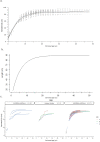Age-specific growth and maturity estimates for the flatback sea turtle (Natator depressus) by skeletochronology
- PMID: 35857751
- PMCID: PMC9299290
- DOI: 10.1371/journal.pone.0271048
Age-specific growth and maturity estimates for the flatback sea turtle (Natator depressus) by skeletochronology
Abstract
To address a major knowledge gap for flatback sea turtles (Natator depressus), a species endemic to Australia and considered 'Data Deficient' for IUCN Red List assessment, we present the first-ever skeletochronology-derived age and growth rate estimates for this species. Using a rare collection of bone samples gathered from across northern Australia, we applied skeletochronology and characterized the length-at-age relationship, established baseline growth rates from the hatchling to adult life stages, and produced empirical estimates of age-at- and size-at-sexual-maturation (ASM, SSM). We analyzed humeri from 74 flatback sea turtles ranging in body size from 6.0-96.0 cm curved carapace length (CCL), and recovered from Western Australia (n = 48), Eastern Australia (n = 13), central Australia (n = 8; Northern Territory n = 3, the Gulf of Carpentaria n = 5), and unknown locations (n = 5). We identified the onset of sexual maturity for 29 turtles, based on rapprochement growth patterns in the bones. Estimates for ASM ranged from 12.0 to 23.0 years (mean: 16.3 ± 0.53 SE), SSM ranged from 76.1 to 94.0 cm CCL (mean: 84.9 ± 0.90 SE), and maximum observed reproductive longevity was 31 years for a 45-year old male flatback. Growth was modeled as a smoothing spline fit to the size-at-age relationship and at the mean SSM (84.9 cm CCL) corresponded with a spline-predicted maturity age of 18 years (95% CI: 16 to 24), while mean nesting sizes reported in the literature (86.4 to 94 cm CCL) corresponded to estimated ages of 24+ years. A bootstrapped von Bertalanffy growth model was also applied and showed consistencies with the spline curve, yielding an estimated upper size limit, Linf, at 89.2 ± 0.04 cm (95% CI: 85.5 to 95.9 cm) with the intrinsic growth rate parameter, k, at 0.185 ± 0.0004 (0.16 to 0.22); at the same mean SSM (84.9 cm CCL) the estimated ASM was 16.3 ± 0.05 years (95% CI: 12.8 to 27.7 years). Lastly, four of the samples analyzed were collected from deceased adult females that had previous sizes known from on-going mark/recapture studies at nesting sites in Western Australia. The paired CCL data (measured at nesting and back-calculated) did not significantly differ (p = 0.875). This first skeletochronology study for flatback sea turtles generates valuable empirical estimates for ongoing conservation and management efforts.
Conflict of interest statement
The authors have declared that no competing interests exist.
Figures






References
-
- Beissinger SR, Westphal MI. On the use of demographic models of population viability in endangered species management. J Wildl Manage. 1998;62(3): 821–841.
-
- Norris K, McCulloch N. Demographic models and the management of endangered species: a case study of the critically endangered Seychelles magpie robin. J Appl Ecol. 2003;40(5): 890–899.
-
- NRC–National Research Council. Assessment of sea-turtle status and trends: integrating demography and abundance. National Academies Press. 2010. doi: 10.17226/12889 - DOI
-
- Crouse DT, Crowder LB, Caswell H. A stage-based population model for loggerhead sea turtles and implications for conservation. Ecol. 1987;68: 1412–1423.
-
- Campbell SP, Clark JA, Crampton LH, Guerry AD, Hatch LT, Hosseini PR, et al.. An assessment of monitoring efforts in endangered species recovery plans. Ecol Appl. 2002;12: 674–681.
Publication types
MeSH terms
LinkOut - more resources
Full Text Sources
Miscellaneous

